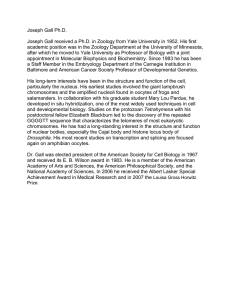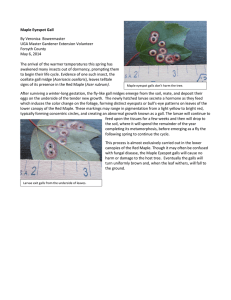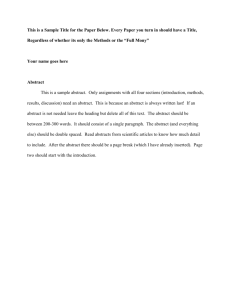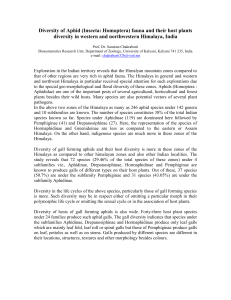Document 13310314
advertisement
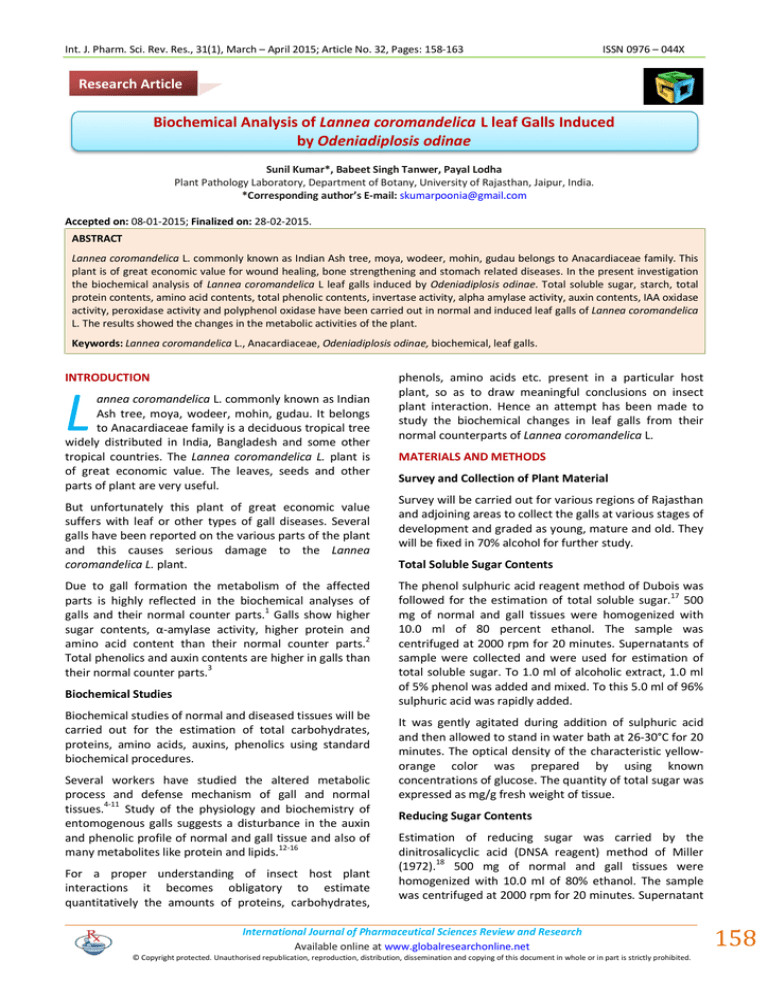
Int. J. Pharm. Sci. Rev. Res., 31(1), March – April 2015; Article No. 32, Pages: 158-163 ISSN 0976 – 044X Research Article Biochemical Analysis of Lannea coromandelica L leaf Galls Induced by Odeniadiplosis odinae Sunil Kumar*, Babeet Singh Tanwer, Payal Lodha Plant Pathology Laboratory, Department of Botany, University of Rajasthan, Jaipur, India. *Corresponding author’s E-mail: skumarpoonia@gmail.com Accepted on: 08-01-2015; Finalized on: 28-02-2015. ABSTRACT Lannea coromandelica L. commonly known as Indian Ash tree, moya, wodeer, mohin, gudau belongs to Anacardiaceae family. This plant is of great economic value for wound healing, bone strengthening and stomach related diseases. In the present investigation the biochemical analysis of Lannea coromandelica L leaf galls induced by Odeniadiplosis odinae. Total soluble sugar, starch, total protein contents, amino acid contents, total phenolic contents, invertase activity, alpha amylase activity, auxin contents, IAA oxidase activity, peroxidase activity and polyphenol oxidase have been carried out in normal and induced leaf galls of Lannea coromandelica L. The results showed the changes in the metabolic activities of the plant. Keywords: Lannea coromandelica L., Anacardiaceae, Odeniadiplosis odinae, biochemical, leaf galls. INTRODUCTION L annea coromandelica L. commonly known as Indian Ash tree, moya, wodeer, mohin, gudau. It belongs to Anacardiaceae family is a deciduous tropical tree widely distributed in India, Bangladesh and some other tropical countries. The Lannea coromandelica L. plant is of great economic value. The leaves, seeds and other parts of plant are very useful. But unfortunately this plant of great economic value suffers with leaf or other types of gall diseases. Several galls have been reported on the various parts of the plant and this causes serious damage to the Lannea coromandelica L. plant. Due to gall formation the metabolism of the affected parts is highly reflected in the biochemical analyses of galls and their normal counter parts.1 Galls show higher sugar contents, α-amylase activity, higher protein and amino acid content than their normal counter parts.2 Total phenolics and auxin contents are higher in galls than 3 their normal counter parts. Biochemical Studies Biochemical studies of normal and diseased tissues will be carried out for the estimation of total carbohydrates, proteins, amino acids, auxins, phenolics using standard biochemical procedures. Several workers have studied the altered metabolic process and defense mechanism of gall and normal tissues.4-11 Study of the physiology and biochemistry of entomogenous galls suggests a disturbance in the auxin and phenolic profile of normal and gall tissue and also of 12-16 many metabolites like protein and lipids. For a proper understanding of insect host plant interactions it becomes obligatory to estimate quantitatively the amounts of proteins, carbohydrates, phenols, amino acids etc. present in a particular host plant, so as to draw meaningful conclusions on insect plant interaction. Hence an attempt has been made to study the biochemical changes in leaf galls from their normal counterparts of Lannea coromandelica L. MATERIALS AND METHODS Survey and Collection of Plant Material Survey will be carried out for various regions of Rajasthan and adjoining areas to collect the galls at various stages of development and graded as young, mature and old. They will be fixed in 70% alcohol for further study. Total Soluble Sugar Contents The phenol sulphuric acid reagent method of Dubois was followed for the estimation of total soluble sugar.17 500 mg of normal and gall tissues were homogenized with 10.0 ml of 80 percent ethanol. The sample was centrifuged at 2000 rpm for 20 minutes. Supernatants of sample were collected and were used for estimation of total soluble sugar. To 1.0 ml of alcoholic extract, 1.0 ml of 5% phenol was added and mixed. To this 5.0 ml of 96% sulphuric acid was rapidly added. It was gently agitated during addition of sulphuric acid and then allowed to stand in water bath at 26-30°C for 20 minutes. The optical density of the characteristic yelloworange color was prepared by using known concentrations of glucose. The quantity of total sugar was expressed as mg/g fresh weight of tissue. Reducing Sugar Contents Estimation of reducing sugar was carried by the dinitrosalicyclic acid (DNSA reagent) method of Miller 18 (1972). 500 mg of normal and gall tissues were homogenized with 10.0 ml of 80% ethanol. The sample was centrifuged at 2000 rpm for 20 minutes. Supernatant International Journal of Pharmaceutical Sciences Review and Research Available online at www.globalresearchonline.net © Copyright protected. Unauthorised republication, reproduction, distribution, dissemination and copying of this document in whole or in part is strictly prohibited. 158 © Copyright pro Int. J. Pharm. Sci. Rev. Res., 31(1), March – April 2015; Article No. 32, Pages: 158-163 of sample thus collected were analyzed for reducing sugars. Estimation of Reducing Sugar 1.0 ml extract of sample was collected separately in test tube. 1.0 ml DNSA reagent was added. The mixture was heated for 5 minutes in boiling water bath. After the color had developed, 1.0 ml of 40% potassium-sodium tartarate was added, while it was still warm. After cooling the tubes in running tap water, the absorbance was measured at 575 nm against the standard prepared from glucose. The quantity of reducing sugars was expressed as mg/g fresh weight of tissue. Starch Contents Method of McCready was followed for estimation of starch.19 500 mg of normal and gall tissues were homogenized with 10.0 ml of 80% ethanol. The sample was centrifuged at 2000 rpm for 20 minutes, supernatant of sample was discarded and the residue was collected. The residual mass obtained after the extraction of total soluble sugars of normal and gall tissues were suspended in 5.0 ml of distilled water and subsequently 6.5 ml of 52% perchloric acid was added to the residue. After stirring the content for 15 minutes, the mixture was centrifuged for 20 minutes at 2000 rpm. The supernatant was decanted and collected. The whole procedure was repeated thrice. Supernatants of step were then pooled and total volume was made upto 100.0 ml with distilled water. The mixture was then filtered through Whatman No. 42 filter paper 1.0 ml aliquot of this filtrate was analysed for starch content following the same procedure as that of total soluble sugars. Quantity of starch was calculated in terms of glucose equivalent and factor 0.9 was used to convert the value of glucose to starch. Quantity of starch was expressed in terms of mg/g fresh weight of tissue. Alpha Amylase Activity Alpha amylase activity was determined by measuring the production of maltose and other reducing sugars from amylopectin of amylase using 3,5-dinitrosalicyclic acid 20 (DNSA) colorimetric procedure of Bernfeld (1955). 200 mg of fresh weight of tissue sample of normal and gall tissues were crushed in 4.0 ml of 0.02 M phosphate buffer (pH 6.9). The homogenate was centrifuged at 2500 rpm for 20 minutes. The supernatant was used to determine the enzyme activity. The reaction mixture consisted of 1.0 ml of enzyme extract and 1.0 ml of substrate solution (1.0 gm soluble starch dissolved in 100 ml of 0.02 M phosphate buffer, pH 6.9 containing 0.0067 M NaCl). The reaction mixture was then incubated at 30°C for 45 minutes and subsequently the reaction was stopped by adding 1.0 ml of DNSA reagent. The tubes were kept in boiling water bath for 15 minutes and then cooled by keeping under tap water immediately. 20 ml of distilled water was added to the ISSN 0976 – 044X cooled mixture. A yellow color developed due to the unhydrolyzed starch. Optical density of this mixture was read at 560 nm against a zero hour blank. The activity was expressed in terms of mg starch hydrolyzed per hour per g fresh weight of tissue. Invertase Activity Method of Harris and Jaffcoat (1974) was followed for the estimation of invertase activity.21 500 mg of normal and gall tissues were crushed in 5.0 ml of 0.2 M acetate buffer (pH 4.8). The reaction mixture consisted of 0.4 ml of 0.4 M sucrose and 0.4 ml of enzyme extract in a test tube. Control was prepared by adding sucrose solution to the test tube in which inactivated enzyme (by boiling) was mixed. Tubes were incubated at 30°C for 30 minutes after adding 1.0 ml of DNSA reagent. Tubes were put in boiling water bath for 10 minutes and then contents were diluted to 10.0 ml by adding distilled water. Optical density was measured at 560 nm. Activity was expressed as mg sucrose hydrolyzed / hour / g fresh weight of the tissue. Total Protein Contents Total contents were estimated following the methods of Lowry.22 500 mg of normal and gall fresh tissues were extracted with 5.0 ml of 5% trichloroacetic acid (TCA). The homogenate was centrifuged at 2000 rpm for 20 minutes and the supernatant was discarded. The residue was dissolved in 5.0 ml of 0.1 N NaOH. 0.1 ml of this solution was made up to 1.0 ml by adding distilled water. 5.0 ml of alkaline copper reagent was added to the dissolved residue and allowed to stand for 10 minutes. 0.5 ml of folin-ciocalteu reagent (diluted with equal volume of water before use) was added rapidly and mixed immediately. The optical density was measured after 10 minutes at 750 nm in a spectrophotometer. For blank, ethanol was used in place of extract. The amount of protein in the sample was calculated with a standard curve prepared from bovine serum albumin. The quantity of protein was expressed as mg/g fresh weight of the tissue. Amino Acids Estimation of total amino acids was made by the method 23 of Lee and Takahashi (1966). 500 mg of normal and gall tissues were crushed in 5 ml of 80% ethanol. The homogenized tissue was kept overnight at room temperature, before being centrifuged at 2500 rpm for 30 minutes. The supernatant was taken for the quantitative extraction of amino acids. 1.0 gm of sample was homogenized with 100 ml of 90% ethanol. The homogenized tissues were stirred, kept overnight at room temperature, centrifuged at 2500 rpm for 30 minutes, and washed three times with 90% ethanol. The supernatant was taken. The supernatant of the sample was shaken vigorously with chloroform (1:3 v/v). The upper aqueous layer of the sample was removed and concentrated in vacuo and was dissolved separately in 24 10% isopropanol and stored at 4°C. The isopropanol International Journal of Pharmaceutical Sciences Review and Research Available online at www.globalresearchonline.net © Copyright protected. Unauthorised republication, reproduction, distribution, dissemination and copying of this document in whole or in part is strictly prohibited. 159 © Copyright pro Int. J. Pharm. Sci. Rev. Res., 31(1), March – April 2015; Article No. 32, Pages: 158-163 fractions were dried separately and finally dissolved in 50% ethanol for amino acid analysis. Three such replicates of the sample was analysed. It was expressed as mg/g fresh weight of tissue. Extraction of Bound Amino Acids The left-over residual tissue from both normal and gall samples were treated separately with 6N HCl.25 The mixture from each was centrifuged (2500 rpm for 30 minutes) and supernatant was taken. It was expressed as mg/g fresh weight of tissue. Estimation of Total, Free and Bound Amino Acids Hydrochloric acid was removed by evaporation of the solution to dryness (25°C). The residues thus obtained were redissolved in 50% ethanol (1.0 ml/1) before using it for analysis of bound amino acids. Isopropanol was used as preservative in order to check esterification of amino acid.26 0.1 ml of extract was taken in a test tube and 5.0 ml of ninhydrin reagent was added to it. The mixture was shaken vigorously and it was heated in a water bath for 12 minutes. The test tubes were cooled under running tap water to room temperature and absorbance was recorded at 570 nm against blank in a spectrophotometer. Blank was prepared by adding 0.1 ml (80%) ethanol in place of extract. The amount of amino acid was calculated using standard curve prepared from glycine and the results were expressed in term of mg/g fresh weight of tissue. Auxin Contents 500 mg (fresh weight) of sample was autoclaved at 120°C for 30 minutes with 10.0 ml of 1N NaOH. After cooling pH was adjusted to 6.0 and the suspension was centrifuged. The supernatant was tested for total auxin contents. Extraction of free auxin contents was done following Avery method.27 500 mg fresh weight of normal and gall tissues were crushed and shaken for 30 minutes with 10.0 ml of glass double distilled water at room temperature. The pH was adjusted to 6.0 and the suspension was centrifuged. The auxin found in this extract was called as “Free auxin”. Estimation of Free and Total Auxins Auxin contents were estimated by following Gordon and 28 Weber’s (1951) method. The reagent was prepared by mixing 1.0 ml of 0.05 M FeCl3 and 50.0 ml of 35% HClO4. 2.0 ml of reagent was added to 1.0 ml of extract. The optical density was measured after 20-25 minutes in a spectrophotometer (UV-VIS-Systronics – 118) at 530 nm against a blank treated similarly. The free and total auxin contents were expressed in terms of µg/g fresh weight of tissue using standard curve plotted by different known concentrations of IAA. IAA Oxidase Activity Sequeria and Mineo’s (1966) method was followed to 29 assay colorimetrically the enzyme activity. 500 mg fresh ISSN 0976 – 044X tissue sample of normal and gall tissues were homogenized in 10.0 ml of chilled phosphate buffer (0.2M at pH 6.0). The homogenate was centrifuged at 1000 rpm in a refrigerated centrifuge (K-24, GDR) for 15 minutes at 0°C. The extract was used for enzyme activity. The reaction mixture consisted of 0.25 ml of 1.0 mM, 2,4dichlorophenol, 1.0 ml of IAA solution (17.5 mg in 100 ml containing 0.5 mM MnCl2.H2O), 3.25 ml of 0.02 M KH2PO4 (pH 4.7) and 1.0 ml of enzyme extract. The mixture was incubated in dark at 30°C for 2 hours. The reaction was terminated by adding 1.0 ml of reaction mixture to 2.0 ml of Salkowaski’s reagent. Absorbance was read at 530 nm after 25 minutes. Initial concentration of IAA was determined by adding Salkowaski’s reagent at zero time and the blank was prepared by taking different concentrations of IAA. The enzyme was expressed in terms of µg of IAA destroyed per hour per mg fresh weight of tissues. Total Phenol Contents Total phenolic contents were estimated by Bray and Thorpe (1954) method.30 500 mg of sample was homogenized in 10 ml of 80% ethanol. The homogenate was centrifuged at 1000-3000 rpm for 20 minutes. The supernatant was collected and residue was re-extracted with 80% ethanol and recentrifuged. After this the supernatant was collected and used for further estimation. Ethanolic extract was used for estimation of total phenols and ortho-dihydroxy phenols. To 1.0 ml of alcoholic extract, 1.0 ml of folin ciocalteau reagent (diluted with equal volume of distilled water before use) followed by 2.0 ml of 20% sodium carbonate were added. The mixture was shaken thoroughly. The samples were placed in a boiling water bath for exactly one minute and then cooled under running tap water. Each of the reaction mixture was diluted to 20.0 ml with distilled water. Optical density was measured at 650 nm against a blank prepared with 80% ethanol. Total phenols were calculated from standard curve prepared from different concentrations of caffeic acid. Total phenols were expressed as mg/g fresh weight of the tissue. Ortho-dihydroxy Phenol Contents Ortho-dihydroxy phenolic contents were determined following the method of Johnson and Schall (1952).31 To 1.0 ml of the alcoholic extract in a test tube, 1.0 ml of 0.5 N HCl, 1.0 ml of Arnow’s reagent and 2.0 ml of 1N NaOH were added and the light pink color obtained was read at 515 nm in a spectrophotometer. Blank comprised of 80% ethanol. Ortho-dihydroxy phenolic contents were calculated from a standard curve prepared from different concentrations of catechol. The results were expressed as mg/g fresh weight of tissue. Peroxidase Peroxidase activity was determined by the method given in Worthington Enzyme Manual (1972).32 500 mg (fresh weight) of sample was homogenized in 10.0 ml chilled International Journal of Pharmaceutical Sciences Review and Research Available online at www.globalresearchonline.net © Copyright protected. Unauthorised republication, reproduction, distribution, dissemination and copying of this document in whole or in part is strictly prohibited. 160 © Copyright pro Int. J. Pharm. Sci. Rev. Res., 31(1), March – April 2015; Article No. 32, Pages: 158-163 ISSN 0976 – 044X 0.2M phosphate buffer (pH=6.1). The homogenate was centrifuged at 5000 rpm in a refrigerated centrifuge for 15 min at 10°C. Enzyme extract (supernatant) thus prepared was assayed for peroxidase. 2.7ml of 0.2M phosphate buffer (pH=6.1), 0.1 ml of 1mM H2O2 0.5ml of enzyme solution were added in a cuvette. The absorbance was calibrated to zero. To the 0.1 ml of 2.0mM o-dianisidine was added and mixed quickly. The absorbance was recorded at 460 nm at 15 second intervals for 10 min. The enzyme activity was expressed in units (change in O.D.)/sec/mg fresh weight of tissue. Polyphenol Oxidase The polyphenol oxidase activity was assayed by the method given by Palmer (1963).33 500 mg fresh weight of sample was homogenized in 10.0 ml chilled phosphate buffer. The homogenate was centrifuged at 2000 rpm in a refrigerated centrifuge for 15 minutes at 0°C. The reaction mixture consisted of 2.0 ml of enzyme extract in 0.033M potassium phosphate buffer, pH (7.0), and 3.0 ml of 5mM solution of DL-DOPA in 0.033M potassium phosphate buffer pH (7.0). Graph 1: Change in carbohydrate contents in leaf gall tissue of Lannea coromandelica L Free auxin and Total auxin contents were more in gall tissues as compared to their normal counterpart. IAA oxidase activity was recorded high in normal tissues as compared to their gall counterpart. Table 2: Change in Auxin contents in leaf gall tissue of Lannea coromandelica L S. No. Auxin content Normal leaf tissue µg/gfw Leaf gall µg/gfw 1 Free auxin 0.5 1.2 2 Total auxin 0.7 1.3 3 IAA oxidase activity 46 41 The increase in optical density at 470 in spectrophotometer after mixing enzyme and substrate was recorded at 15 seconds interval upto 3 minutes. *µ IAA destroyed/hr/mg fresh weight of tissue. The reaction mixture without the substrate was used as a blank. Enzyme activity was expressed in terms of units (change in O.D.)/sec/g fresh weight of tissue. RESULTS AND DISCUSSION Table 1: Change in carbohydrate contents in leaf gall tissue of Lannea coromandelica L S. No. Carbohydrate Normal leaf tissue mg/gfw Leaf gall mg/gfw 1 Total soluble sugar contents 2.3 2.4 2 Reducing sugar contents 0.7 0.9 3 Starch contents 0.9 0.7 4 Alpha amylase activity 0.36 0.5 5 Invertase activity 0.13 0.15 Total soluble sugar contents and reducing sugar contents were more in gall tissue as compared to normal counterparts. While Total starch contents were more in normal tissues as compared to gall. Increased alpha amylase activity was recorded in all the normal plant tissues as compared to galls. Invertase activity was recorded more in gall tissues as compared to their normal counterparts. Graph 2: Change in Auxin contents in leaf gall tissue of Lannea coromandelica L Gall tissues showed increased total protein, total amino acid, free amino acid and protein bound amino acid contents as compared to their normal counterparts. Table 3: Change in Protein and Amino acid contents in leaf gall tissue of Lannea coromandelica L S. No. Protein and Amino acid Normal leaf tissue mg/gfw Leaf gall mg/gfw 1 Total protein content 2.4 2.5 2 Total amino acid content 0.16 0.21 3 Free amino acid content 0.09 0.13 4 Protein bound amino acid content 0.05 0.07 International Journal of Pharmaceutical Sciences Review and Research Available online at www.globalresearchonline.net © Copyright protected. Unauthorised republication, reproduction, distribution, dissemination and copying of this document in whole or in part is strictly prohibited. 161 © Copyright pro Int. J. Pharm. Sci. Rev. Res., 31(1), March – April 2015; Article No. 32, Pages: 158-163 ISSN 0976 – 044X The results obtained during present investigation indicate interesting aspect of phenol metabolism of gall and normal tissues of Lannea coromandelica L. In general gall tissues of leaf showed higher total phenolic and ortho-dihydroxy phenolic contents as compared to their normal counterparts. Higher peroxidase activity was recorded in gall tissues as compared to their normal counterparts. Graph 3: Change in Protein and Amino acid contents in leaf gall tissue of Lannea coromandelica L Total phenol and ortho-dihydroxy phenol contents were recorded more in gall tissue as compared to their normal counter parts. Higher peroxidase activity was observed in gall tissues as compared to their normal counterparts. While higher polyphenol oxidase activity was recorded in normal tissues of leaf as compared to gall tissues. Table 4: Change in Phenolics contents in leaf gall tissue of Lannea coromandelica L S. No. Phenolics and oxidative enzyme Normal leaf tissue mg/gfw Leaf gall mg/gfw 1 Total phenol content 1.3 2.7 2 Ortho-dihydroxy phenol content 0.7 1.2 3 Peroxidase activity 0.43 0.48 4 Polyphenol oxydase 0.5 0.35 Normal tissues showed higher polyphenol oxidase activity as compared to gall tissues. High phenolic and ortho-dihydroxy phenolic contents in galls could be correlated to low polyphenol oxidase activity in the same. Acknowledgement: One of the authors Mr. Sunil Kumar is thankful to UGC for providing financial support as file no 2011/855. REFERENCES 1. Ramani V, Kant U, Phenolics and enzymes involved in phenol metabolism of gall and normal tissues of Prosopis cineraria (Linn.) Druce in vitro and in vivo. Proc. Indian Nat. Sci. Acad., B55 (5&6), 1989, 417-420. 2. Jain P, Qureshi M.A, Kant U, Dual culture of nematode (Melidogyne incognita) on Lablab purpureus L. in vitro. VII Inter. Cong. on Plant Tissue and Cell Culture, 24-29 June Amsterdam, 1990, 54. 3. Kant U Arora D.K, Ramani V, In Tissue culture and Biotechnology of Medicinal and Aromatic Plants. Kukreja A.K, Mathur A.K, Ahuja P.S, Thakur R.S, Eds., CIMAP. Lucknow, 1989, 129-133. 4. Kant U, Plant Teratomas - Causes and Consequences; Presidential address, In 87th Session ISCA, Puna, 2000, 131. 5. Moshe I., Meyer R.T, Doostdar H, Induced activity of pathogenesis related (PR) proteins in aphid galls Symbiosis, 34, 2003, 293-300. 6. Sugiura S., Yamazaki K, Fukasawa Y, Weevil parasitism of ambrosia galls, Ann. Entomol. Soc. Am, 97, 2004, 184-193. 7. Rana A., Chauhan S, Chauhan S.V.S, Ultrastructural and biochemical changes in Alstonia scholaris (L.) leaf galls induced by Pauropsylla tuberculata Crawf, In: (Ed.) S. Kumar Plant Science Research in India: Challenges and Prospectus, Botanical Survey of India, Dehradun, 2005, 139-150. 8. Sharma B.S., Rana A, Chauhan S.V.S, Biochemical changes in anther galls of Crataeva reliogiosa induced by the insect Neolasioptera crataevae, J. Mycol. Pl. Pathol. 36(2), 2006, 253-257. 9. Izzo T.J., Julião G.R., Almada E.D, Fernandes G.W, Hiding from defenders: localized chemical modification on the leaves of an Amazonian ant-plant induced by a gallmaking insect (Diptera: Cecidomyiidae), Sociobiology, 48, 2006, 417–426. Graph 4: Change in Phenolics contents in leaf gall tissue of Lannea coromandelica L CONCLUSION Total soluble sugar contents were more in gall tissues than normal counterparts. Reducing sugar and invertase activity were more in gall tissue as compared to normal tissue. Low alpha amylase activity was recorded in the gall tissues as compared to normal counterpart. High starch contents in gall tissue were found which could be correlated with low alpha amylase activity in the same. In general, gall tissues of leaf showed higher auxin (total and free) contents as compared to their normal counterparts. Normal tissues showed creased IAA oxidase activity. The increased auxin contents of gall tissues could be correlated to decreased IAA oxidase activity. 10. Tooker J.F, De Moraes C.M, (Feeding by Hessian fly [Mayetiola destructor (Say)] larvae does not induce plant International Journal of Pharmaceutical Sciences Review and Research Available online at www.globalresearchonline.net © Copyright protected. Unauthorised republication, reproduction, distribution, dissemination and copying of this document in whole or in part is strictly prohibited. 162 © Copyright pro Int. J. Pharm. Sci. Rev. Res., 31(1), March – April 2015; Article No. 32, Pages: 158-163 indirect defenses, Ecological Entomology, 32, 2007, 153161. 11. Tooker J.F, Rohr J.R., Abrahamson W.G, De Moraes C.M, Gall insects can avoid and alter indirect plant defenses, New Phytologist, 178, 2008, 657-671. ISSN 0976 – 044X of carnation. Ann. Bot. 38, 1974, 77-83. 22. Lowry O.H., Rosebrough N.J., Far A.L. and Randell R.J. Protein measurement with Folin-phenol reagent. J. Biol. Chem. 193, 1951, 265-275. 12. Kant U, Ramani V, Insect induced galls in tissue culture, Proc. Indian Acad. Sci. (Animal Sc), 99, 3, 1990, 257-267. 23. Lee Y.P. and Takahashi T. An improved colorimetric determination of amino acids with the use of ninhydrin. Ann. Biochem. 14, 1966, 71. 13. Hartley S.E, The chemical composition of plant galls: Are levels of nutrients and secondary compounds controlled by the gall former? Oecologia, 113, 1998, 492-501. 24. Awapara J. Application of paper chromatography to the estimation of free amino acids in tissues. Arch. Biochem. 19, 1948, 172-173. 14. Ullrich C.I., Aloni R, Vascularization is a general requirement for growth of plant and animal tumours, J. Exp. Bot, 51, 2000, 1951-1960. 25. Black R.J., Durrum E.L. and Swig G. A manual chromatography and paper electrophoresis. Acad. Press. Inc. Publishers, New York, 1958, 374-375. 15. Kempf V.A.J., Hitziger N., Reiss T, Autenrieth I.B, Do plant and human pathogens have a common pathogenecity strategy? Trends Microbiol, 10, 2002, 269-275. 26. Block R.J. and Boiling D. The amino acid composition of proteins and food. C.C. Thomas, Springfield, 1951, 576. 16. Florentine S., Raman A, Dhileepan K, Effect of gall induction by Epiblema strenuana on gas exchange, nutrients and energetics in Parthenium hysterophorus, Biocontrol, 50(5), 2005, 787-801. 27. Avery G.S., Berger J. and White R.O. Rapid total extraction of auxin from green plant tissue. Am. J. Bot. 32, 1945, 188-191. 28. Gordon S.A. and Weber R.P. Colorimetric estimation of indole acetic acid. Plant Physiol. 216, 1951, 192-195. 17. Dubois M, Gilles K.A., Hamilton J.K., Rebers P.A. and Smith F. Colorimetric determination of sugars and related substances. Analyt. Chem. 26, 1951, 351-356. 29. Sequeira L. and Mineo I. Partial purification and kinetics of indole acetic acid oxidase from tobacco roots. Plant Physiol. 41, 1966, 1200-1208. 18. Miller G.L. Use of dinitro-salicylic acid reagent for determination of reducing sugar. Anal. Chem. 31, 1972, 426-428. 30. Bray H.C. and Thorpe W.V. Analysis of phenolic compounds of interest in metabolism. Meth. Biochem. Analysis. 1, 1954, 27-52. 19. McCready R.M., Guggolz J., Silviera V. and Ownes. H.S. Determination of starch and amylase in vegetables, application to peas. Anal. Chem. 22, 1950, 1156-1158. 31. Johanson G. and Schall L.A. Relation of chlorogenic acid to scab resistance in potatoes. Science. 115, 1952, 627-629. 20. Bernfeld P. Alpha and Beta amylases. Methods in Enzymology. 1, 1955, 149-158. 21. Harris G.P. and Jaffcoat B. Effects of temperature on the 14 distribution C labeled assimilates in the flowering shoot 32. Worthington-Enzyme Manual Enzymes, enzyme reagents, related biochemicals, Worthington Corporation Freehold, New Jersey, U.S.A. 1972, 216. 33. Palmer J.K. Banana polyphenol oxidase, preparation and properties. Plant Physiology. Lancaster. 38, 1963, 508513. Source of Support: Nil, Conflict of Interest: None. International Journal of Pharmaceutical Sciences Review and Research Available online at www.globalresearchonline.net © Copyright protected. Unauthorised republication, reproduction, distribution, dissemination and copying of this document in whole or in part is strictly prohibited. 163 © Copyright pro
